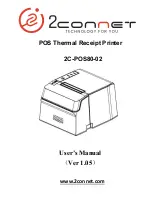
6
Using a TCP/IP Network
Setting Up a Computer as a File Server
6-30
FTP Server Settings
Windows 2000/XP/Server 2003/Server 2008/Vista
This section describes the procedures for using the default home directory under [Default FTP Site]. To use other settings,
enter the FTP site and home directory by referring to the IIS documentation.
It is recommended that the FTP server be configured by the network administrator.
In the following procedures, items displayed on the screens for Windows 2000 are used. The items displayed may differ
according to your operating system.
The use of Windows 2000 Server/XP Professional/Server 2003/Vista as an FTP server requires the installation of IIS. If IIS is not installed
in the computer you are using, you will need to install the version of IIS for the operating system you are using before entering these
settings. (See "System Requirements" in “Sending Data,” on p. 4-6.) For installation procedures, see the manuals provided with your
operating system.
User authentication for access to FTP servers is performed using the local account database of Windows 2000 Server/XP Professional/
Server 2003/Vista used as the FTP server. Therefore, it is not possible to use the account of a domain user registered in Windows 2000
Server/XP Professional/Server 2003/Vista to send data directly from the machine to FTP servers in other domains.
If you are using Windows Vista, a dialog box may be displayed while you are performing the procedure. In this case, enter a user name and
password. For more information, see the manuals provided with the operating system.
1
Log on to Windows as a member of the group with access rights to the directory to be
designated as the FTP site directory
→
start IIS .
Depending on your environment, the access rights settings for a drive or directory may differ. For details, see the Windows manual.
2
In the [Default FTP Site Properties] dialog box, on the [Security Accounts] sheet, deselect the
option which allows only anonymous connection .
•
•
Summary of Contents for IMAGERUNNER ADVANCE C5051
Page 2: ......
Page 3: ...imageRUNNER ADVANCE C5051 C5051i C5045 C5045i C5035 C5035i C5030 C5030i Getting Started...
Page 64: ...2 Flow of Settings Operations Required to Use the Machine 2 14...
Page 90: ...4 Before Connecting to a Network Checking Your Network Environment 4 12...
Page 108: ...5 Settings Common to the Network Protocols Communication Environment Setup 5 18...
Page 174: ...8 Using an SMB CIFS Network Setting Up a Computer as a File Server 8 16...
Page 178: ...9 Using an AppleTalk Network Macintosh Protocol Settings 9 4...
Page 196: ...11 Before Using the Fax Function Remote Fax Settings 11 12...
Page 206: ...12 Before Printing from Computers Other Software Programmes 12 10...
Page 216: ...14 Before Using the Remote Scan Function Settings Required Prior to Remote Scanning 14 6...
Page 251: ......
















































